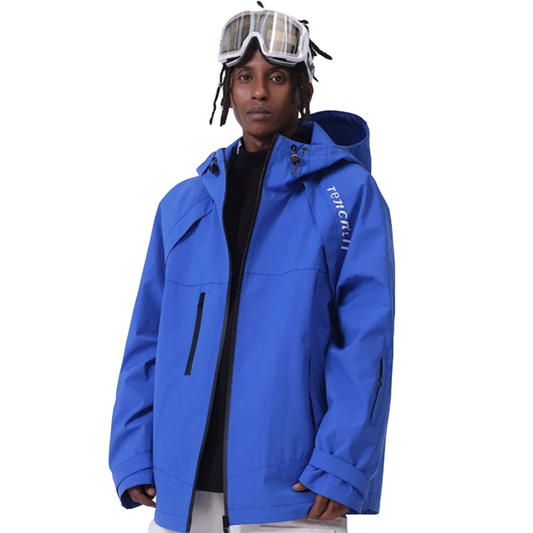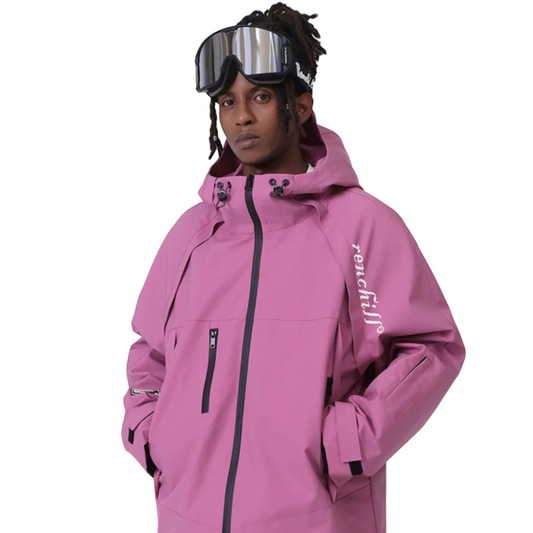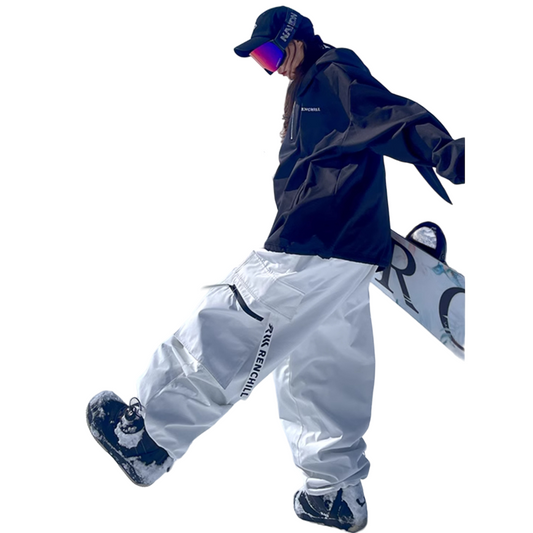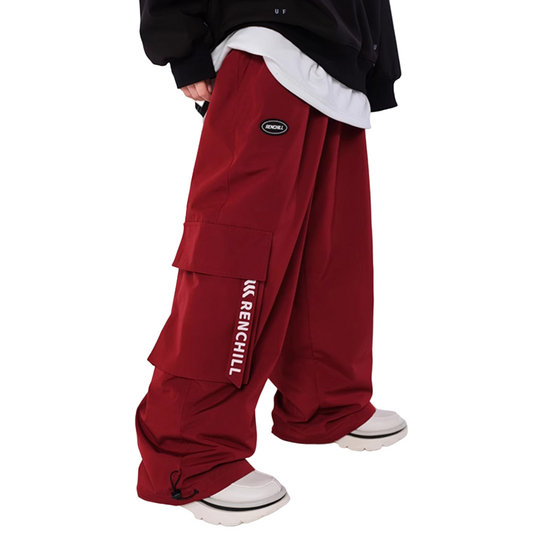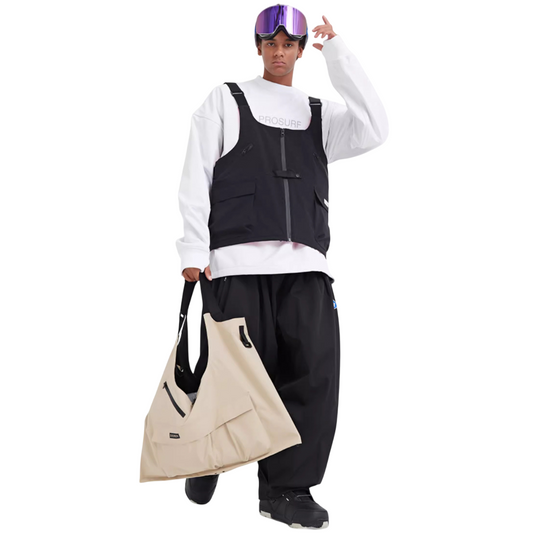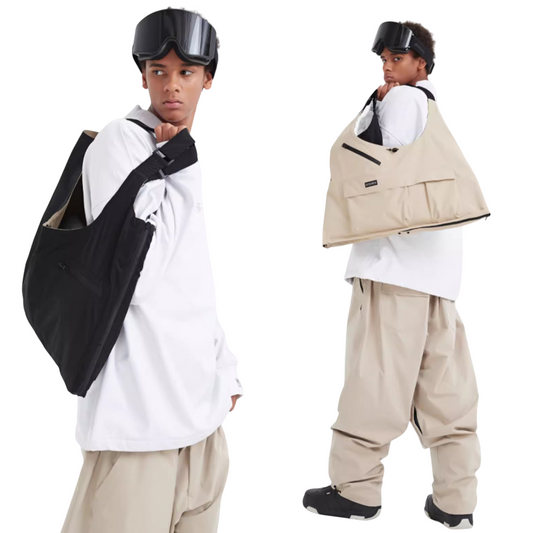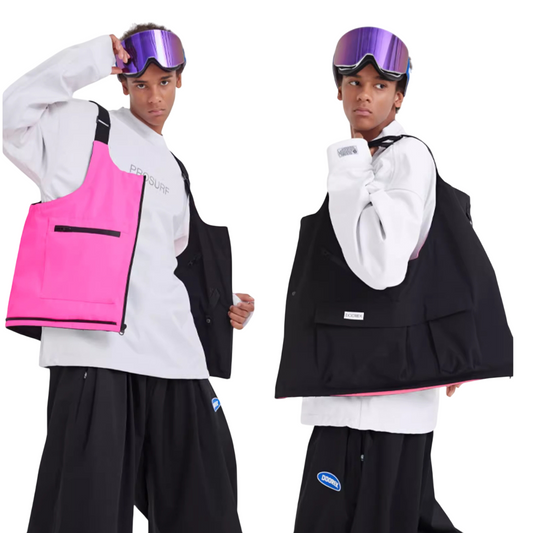You want the best snowboarding jackets for your freestyle or all-mountain adventures. Popular brands like Burton, Volcom, and 686 lead the market with features that boost comfort and protection.
|
Brand |
Annual Units Sold |
Key Features & Technologies |
|---|---|---|
|
Burton |
500,000+ |
Gore-Tex, 20,000 mm waterproofing, 95% weather protection |
|
Volcom |
N/A |
V-Science fabric, stylish, 15% recycled materials |
|
686 |
350,000+ |
3-in-1 jackets, 10,000 mm waterproofing |
|
Quiksilver |
450,000+ |
10,000 mm waterproofing, stylish designs |
|
Helly Hansen |
400,000+ |
Helly Tech, 15,000 mm waterproofing |

SNOWMOCACA Ski Jacket gives you versatility for both styles and free shipping on orders over $99. Always check fit, material, insulation, and style when choosing your snowboard jacket. 🏂❄️
Key Takeaways
- Choose a snowboard jacket that fits your riding style: baggy and flexible for freestyle, snug and warm for all-mountain.
- Look for key features like waterproofing, breathability, adjustable hoods, vents, and powder skirts to stay comfortable and protected.
- Try on jackets with your layers and gear to ensure a good fit, mobility, and warmth before buying.
Freestyle vs. All-Mountain Jackets
Key Differences
When you look for the best snowboarding jackets, you will notice clear differences between freestyle and all-mountain designs. Freestyle jackets focus on flexibility and movement. You often see a baggier fit, which gives you extra room for tricks like spins and grabs. This loose style helps you move freely on your snowboard.
All-mountain jackets have a more relaxed but less oversized fit. These jackets balance warmth, layering, and movement. You get enough space to move, but the jacket stays close enough to your body to keep you warm on long rides. The fit in all-mountain jackets supports both comfort and protection across different terrains.
- Freestyle snowboarders prefer a baggier fit for maximum flexibility.
- All-mountain riders choose a relaxed, snug fit for warmth and movement.
- Freestyle jackets focus on looseness, while all-mountain jackets balance fit and coverage.
Why Riding Style Matters
Your riding style shapes your snowboard jacket choice. If you ride freestyle, you need a jacket that lets you twist, jump, and grab your snowboard without restriction. A loose fit and lightweight materials help you perform tricks and stay comfortable.
All-mountain riders face changing weather and terrain. You need a snowboard jacket that keeps you warm, dry, and protected. Many riders pick insulated jackets for warmth or shell jackets for breathability and weather protection. Features like helmet-compatible hoods, snow skirts, and vents become important based on your needs.
- Insulated jackets work well for casual or resort riders who want warmth.
- Shell jackets suit advanced riders who need protection and breathability.
- Jacket features like pockets, vents, and storm flaps change based on your riding style and the conditions you face.
Choosing the right fit and features ensures your snowboard jacket matches your style and keeps you comfortable on every run.
Best Snowboarding Jackets: Top Picks
Freestyle Favorites
When you ride freestyle, you need a snowboard jacket that gives you freedom to move and keeps you dry. The best snowboarding jackets for freestyle riders focus on flexibility, breathability, and durability. You want a jacket that handles high-energy tricks and protects you from snow and wind.
|
Jacket Model |
Key Features |
Why It Suits Freestyle Riders |
|---|---|---|
|
Burton [ak] Swash GORE-TEX 2L |
60g PrimaLoft Silver insulation, 2-layer GORE-TEX waterproofing, pit zips, mitten-friendly zippers |
Provides warmth, breathability, and mobility needed for dynamic freestyle riding |
|
Taian BOWINS Custom Made |
100% polyester with PU membrane, 10,000mm waterproof rating, customizable fit, sealed seams, durable zippers |
Customizable fit and high waterproofing protect riders in varied freestyle conditions |
|
Arc’teryx Sabre AR Jacket |
3-layer GORE-TEX, articulated design for range of motion, helmet-compatible StormHood, abrasion-resistant fabric |
Lightweight shell with ergonomic design ideal for freestyle mobility and protection against terrain park abuse |
Recent gear reviews show that the best snowboarding jackets for freestyle balance waterproofing and breathability. Jackets like the Arc’teryx Sabre use articulated designs for better mobility. You get helmet-compatible hoods and durable fabrics to handle park abuse. Freestyle riders often choose looser fits for layering and unrestricted movement.
Tip: Look for snowboard jackets with pit zips and adjustable hoods. These features help you stay cool and protected during intense sessions.
Pros and Cons Table for Freestyle Jackets
|
Aspect |
Pros |
Cons |
|---|---|---|
|
Fit |
Looser cuts allow easy movement and layering. |
Some jackets may feel bulky for smaller riders. |
|
Flexibility |
Articulated patterns and relaxed fits boost flexibility. |
Extra insulation can reduce flexibility in some models. |
|
Weather Protection |
GORE-TEX and sealed seams keep you dry and shielded from wind. |
Premium materials can raise the price. |
All-Mountain Essentials
All-mountain riders need a snowboard jacket that adapts to changing weather and terrain. The best snowboarding jackets for all-mountain use combine warmth, weather protection, and comfort. You want a jacket that works for powder days, icy mornings, and sunny afternoons.
Some top picks for all-mountain riders include:
- 686 Smarty 3-in-1 Jacket: This jacket stands out for its 3-in-1 design. You get a waterproof shell and a removable insulated liner. The 3-in-1 system lets you adjust for different temperatures and conditions. Mesh-lined vents and a powder skirt add extra comfort and protection.
- Columbia Highland Summit: This insulated snowboard jacket uses Omni-Tech technology for waterproofing. Eco-friendly insulation keeps you warm on cold days. Large pockets and an adjustable hem make it practical for long rides.
- REI Co-op Jackets: These jackets offer a relaxed fit for layering. You get a helmet-compatible hood, powder skirt, and plenty of storage. The Gore-Tex membrane provides reliable weather protection.
|
Model |
Waterproofing |
Insulation Type |
Best Use Cases |
Price Range |
|---|---|---|---|---|
|
686 Smarty 3-in-1 |
20k waterproof shell |
Removable insulated liner (100-160g) |
Resort skiing, snowboarding, variable weather |
Mid-range |
|
Columbia Highland Summit |
Omni-Tech™ technology |
Eco-friendly insulation |
Cold, stormy days, resort skiing |
Under $200 |
|
REI Co-op Jackets |
Gore-Tex membrane |
Insulated |
Resort skiing, snowboarding, and everyday use |
Reasonable price |
All-mountain jackets often use 3-in-1 systems or insulated liners. You get flexibility for layering and warmth. These snowboard jackets focus on a balance of fit, insulation, and weather protection.
Note: Many brands offer free shipping on orders over $99, making it easier to get the best snowboarding jackets delivered to your door.
SNOWMOCACA Ski Jacket Review
The SNOWMOCACA Ski Jacket gives you a budget-friendly option for both freestyle and all-mountain riding. This snowboard jacket stands out for its strong waterproofing and insulated design. You get adjustable cuffs, a helmet-compatible hood, a powder skirt, and multiple pockets. The jacket feels slightly bulkier than some premium models, but it keeps you warm on cold days.
|
Feature / Model |
SNOWMOCACA Ski Jacket |
686 Smarty 3-in-1 |
Columbia Highland Summit |
|---|---|---|---|
|
Waterproofing |
Excellent for price; strong waterproofing |
20k waterproof shell; strong waterproofing |
Omni-Tech™ technology rivals expensive jackets |
|
Insulation |
Warm, insulated design ideal for cold days |
Removable insulated mid-layer; 100-160g insulation |
Eco-friendly insulation; excellent warmth |
|
Breathability |
Less breathable; bulkier; not ideal for high-output |
Mesh-lined underarm vents; good breathability |
Good with underarm vents |
|
Design & Features |
Adjustable cuffs, helmet-compatible hood, powder skirt, multiple pockets, durable and stylish |
3-in-1 versatility, adjustable hood, powder skirt |
Powder skirt, adjustable hem, large pockets |
|
Bulk & Mobility |
Slightly bulkier; less suited for spring/high-output |
Bulkier; some fit issues |
Slightly stiff fabric; good mobility after break-in |
|
Best Use Cases |
Resort skiing, snowboarding, and budget-conscious users |
Resort skiing, snowboarding, versatile weather use |
Cold, stormy days; resort skiing |
|
Price Range |
Budget-friendly |
Mid-range |
Under $200 |
Pros:
- Strong waterproofing for the price
- Insulated for warmth on cold days
- Adjustable features for comfort and fit
- Multiple pockets for storage
Cons:
- Less breathable than premium jackets
- A bulkier feel may limit mobility for high-output riding
You get great value with the SNOWMOCACA Ski Jacket, especially if you want insulated snowboard jackets without breaking the bank. This jacket works best for resort skiing and snowboarding in cold weather. If you order now, you can take advantage of free shipping on orders over $99.
Deal Alert: Free standard shipping is available on orders over $99. This offer helps you save on your next snowboard jacket purchase.
How to Choose a Snowboard Jacket
Choosing the right snowboard jacket can make a big difference in your comfort and performance on the mountain. You need to consider several factors, including fit, material, insulation, and length. Follow these steps to find the best option for your riding style and conditions.
Fit and Sizing
Fit is one of the most important things to check when you shop for a snowboard jacket. A good fit lets you move freely, layer clothing, and stay warm. You want enough room for a base layer and a mid layer, but not so much that the jacket feels bulky.
- Try on the jacket with your usual snowboarding layers.
- Lift your arms and twist your body to check mobility.
- Make sure the sleeves cover your wrists, even when you reach forward.
- The hem should cover your lower back when you sit or bend.
Jacket fit varies by style. Freestyle riders often prefer a looser fit for tricks and grabs. All-mountain riders may choose a regular fit for warmth and coverage. Always check the size chart for each brand, as sizing can differ.
Tip: Move around in the jacket before buying. You should feel comfortable and unrestricted.
Material and Shell Types
The material and shell type of your snowboard jacket affect protection, breathability, and comfort. Shell snowboard jackets come in different styles, each with unique benefits.
- Hardshells: These jackets offer the best waterproofing and wind protection. They feel heavier and less breathable, but keep you dry in harsh weather. Hardshells work well for resort riding and have features like powder skirts and multiple pockets.
- Softshells: These jackets feel stretchy and comfortable. They breathe better than hardshells but are less waterproof. Softshells suit backcountry touring and mild conditions.
- 3-in-1 jackets: These combine a shell with a removable insulated liner. You get versatility for changing weather, but sometimes the fit and performance do not match dedicated shells or insulated snowboard jackets.
Common materials include polyester and nylon. Polyester resists shrinking and dries quickly. Nylon is strong and elastic. Premium jackets may use microfibers for lightweight strength or Gore-Tex membranes for top waterproofing and breathability. Shell snowboard jackets with taped seams, waterproof zippers, and adjustable cuffs give you extra protection.
Shell jackets provide flexibility for layering. Insulated snowboard jackets add warmth but can feel bulkier and less breathable. Your choice of shell or insulated jacket depends on your riding style and local weather.
Insulation Options
Insulation keeps you warm on cold days. You can choose from several types, each with pros and cons.
|
Insulation Type |
Best For |
Key Features |
|---|---|---|
|
Down |
Dry, very cold conditions |
Light, warm, but loses warmth when wet unless treated |
|
Synthetic |
Wet or variable climates |
Stays warm when wet, heavier than down |
|
Insulated Jackets |
Consistently cold weather |
Built-in warmth, less breathable, can overheat |
|
Shell Jackets |
Changing conditions |
No insulation, rely on layering for warmth |
|
Softshell Jackets |
Mild or casual use |
Moderate warmth, less waterproof, more comfort |
Down insulation gives you the best warmth-to-weight ratio. It works well in dry, cold weather. Synthetic insulation stays warm even when wet, making it a smart choice for wet or changing conditions. Insulated snowboard jackets use built-in insulation, which is great for cold days but may feel too warm in mild weather. Shell snowboard jackets let you add or remove layers as needed.
Note: Layering helps you adjust insulation for different temperatures. Use a base layer to wick sweat, a mid layer for warmth, and a shell for weather protection.
Length and Coverage
Jacket length affects warmth and coverage. Snowboard jackets often have a longer cut than ski jackets. This extra length covers your backside, which helps when you sit on the snow or ride in deep powder.
|
Feature |
Ski Jacket |
Snowboard Jacket |
|---|---|---|
|
Length |
Standard |
Longer for extra coverage |
|
Warmth |
Slim fit, traps heat |
Room for layering, adaptable |
|
Coverage |
Balanced for movement |
Enhanced for sitting on snow |
|
Mobility |
Prioritizes quick moves |
Balances coverage and mobility |
A longer snowboard jacket keeps snow out and adds warmth. It also gives you space for layering. Some riders prefer shorter jackets for better mobility, but you may lose some protection. Look for features like adjustable hoods, powder skirts, and wrist gaiters to boost coverage.
Tip: Always check how the jacket feels when you sit or crouch. The right length keeps you warm and dry all day.
Layering for Warmth and Comfort
Layering is key to staying warm and comfortable. Use a three-layer system:
- Base layer: Wicks moisture and traps heat. Merino wool or synthetic fibers work best.
- Mid layer: Adds insulation. Fleece, wool, or lightweight down are good choices.
- Outer layer (shell): Protects against wind, snow, and moisture. Choose a waterproof and breathable shell snowboard jacket.
Adjust your layers based on the weather and your activity level. Avoid cotton, as it holds moisture and can make you cold. Accessories like thermal neck warmers, insulated gloves, and proper socks complete your setup.
Pro Tip: Try on your full layering system with your snowboard jacket before hitting the slopes. Make sure you can move easily and stay comfortable.
Snowboard Jacket Features
Waterproofing and Breathability
When you choose a snowboard jacket, waterproofing and breathability are two of the most important features. Waterproofing keeps you dry by blocking snow and rain. Breathability lets sweat escape so you stay comfortable during activity. Most snowboard jackets have waterproofing ratings measured in millimeters. A rating of 10,000 mm is standard for regular riding. High-performance jackets, like those with GORE-TEX, can reach 20,000 mm or more. Breathability rating shows how well the shell lets moisture out. A rating of 10,000 g/m²/24hr works well for most riders. Higher breathability helps if you ride hard or hike in the backcountry.

|
Waterproof Rating (mm) |
Water Resistance Level |
Suitable Conditions |
|---|---|---|
|
0-5,000 |
Minimal |
Light rain, dry snow |
|
6,000-10,000 |
Rainproof |
Light rain, average snow |
|
11,000-15,000 |
Rainproof except under high pressure |
Moderate rain, average snow |
|
16,000-20,000 |
Rainproof under high pressure |
Wet snow, heavy rain |
|
20,000+ |
Rainproof under very high pressure |
Heavy rain, wet snow |
Freestyle riders often want a lighter shell with good breathability for tricks and movement. All-mountain riders may need a waterproof jacket with higher ratings for harsh weather.
Vents and Pockets
Venting systems, like pit zips, boost airflow and help you cool down during intense sessions. Pockets add storage for your pass, phone, or snacks. These jacket features make your day easier on the mountain.
- Pit zips let you release heat quickly.
- Media pockets keep your phone safe.
- Pass pockets give you fast access at the lift.
Freestyle riders use vents to stay cool in the park. All-mountain riders rely on pockets for long days and changing weather.
Powder Skirts and Cuffs
Powder skirts and adjustable cuffs keep snow out of your jacket. The powder skirt fits around your waist to block snow during falls. Cuffs and wrist gaiters seal your sleeves and keep cold air out.
- Powder skirts stop snow from entering at the waist.
- Adjustable cuffs and gaiters block snow at the wrists.
These snowboard jacket features help you stay warm and dry, whether you ride in deep powder or practice tricks.
Hoods and Helmet Compatibility
A good hood protects your head from wind and snow. Many snowboard jackets have helmet-compatible hoods. This feature lets you wear your helmet and stay covered. Freestyle riders want a hood that moves with them. All-mountain riders need a hood that fits over a helmet for extra protection.
Choose a snowboard jacket with the right features for your style and conditions. The right shell, waterproofing, and breathability rating keep you comfortable all day.
How Should a Snowboard Jacket Fit
Choosing the right snowboard jacket fit is key for warmth, movement, and layering. You want a jacket that lets you move freely, keeps you warm, and works well with your gloves and gear.
Fit Types: Regular, Slim, Baggy
You will find three main fit types for snowboard jackets: regular, slim, and baggy. Baggy fit gives you extra room to move, which helps when you do tricks or need to layer up. Many freestyle riders like this style because it does not restrict movement. Slimmer fits keep the jacket close to your body, reducing bulk and making it easier to control your board. Regular fit sits between these two, offering comfort and flexibility for most riders. Manufacturers often offer several fit options for the same model, so you can pick what matches your riding style.
Length: Waist, Hip, Thigh
Snowboard jackets usually run longer than ski jackets. You will see lengths that reach the hip or even the thigh. This extra length covers your lower back and backside, which is important when you sit or kneel in the snow. Longer jackets help keep snow out and add warmth. Features like powder skirts, adjustable hoods, and vents work with the jacket length to boost comfort and protection.
Layering and Mobility
Layering under your snowboard jacket helps you stay warm and mobile. Use a three-layer system: a base layer to wick sweat, a mid layer for warmth, and your outer shell for weather protection. Avoid cotton because it traps moisture. Do not wear too many layers, as this can make you sweat and lose warmth. Look for wrist gaiters and adjustable cuffs, which keep your sleeves in place and seal out snow when you wear gloves. These features make sure your jacket fit supports both comfort and performance on the mountain.
Tip: Always try on your jacket with your gloves and layers to check coverage and mobility before you hit the slopes.
More Tips and Deals
Womens and Youth Jackets
You have many great choices if you want a snowboarding jacket for women or youth. Top-rated options include:
- Arc'teryx Andessa Jacket: Combines down and synthetic insulation for warmth and moisture control. Features a waterproof GORE-TEX shell, removable powder skirt, and helmet-compatible hood.
- Burton AK Gore-Tex Embark Jacket: Offers PrimaLoft Silver insulation, mesh-lined vents, and a Living Lining for climate control.
- Outdoor Master Women's 3-in-1: Budget-friendly with a waterproof shell and removable fleece liner. Adjustable cuffs and a removable hood add flexibility.
- Volcom Fawn Insulated Jacket: Features a V-Science 2-layer membrane, polyfill insulation, and a slim fit with extra length.
These jackets focus on warmth, waterproofing, and features like helmet-compatible hoods and powder skirts. Youth jackets often use lighter shells for easy movement and larger cuts for layering.
Vintage and Retro Styles
You can stand out on the slopes with vintage or retro snowboard jackets. Many brands now offer throwback designs with bold colors and classic patterns. These jackets often use modern materials, so you get old-school style with new-school performance. Look for features like waterproof membranes, pit zips, and adjustable cuffs in these retro-inspired pieces.
Affordable and Sale Options
You do not need to spend a lot to get a quality snowboard jacket. Many riders find the best deals by shopping last season’s models or clearance sales. Jackets from brands like 686, Burton AK, and Salomon often drop below $200 during sales. Focus on key features such as a waterproof rating of at least 10,000 mm, taped seams, powder skirts, and wrist gaiters. Some clearance jackets sell for as low as $60. Backcountry and other major retailers run semi-annual sales with up to 50% off, especially on women’s ski jackets. Signing up for alerts can also get you extra discounts.
Tip: Prioritize function over brand or color. Look for waterproofing, breathability, and fit to get the best value.
Internal Link: More Snowboarding Tips from SNOWMOCACA
You can find more snowboarding tips and guides on the SNOWMOCACA blog. The blog covers how to choose the right snowboard for your style and terrain, explains board types, and gives advice for beginners. You will learn about sizing, flex, and how to match your gear to your riding goals. These guides help you build confidence and improve your skills on the mountain.
You can choose the best snowboarding jacket by focusing on your riding style, weather, and key features:
- Pick shell or insulated jackets based on climate and layering needs.
- Look for adjustable hoods, vents, powder skirts, and secure pockets.
- Ensure a fit that allows free movement.
SNOWMOCACA, Evo, and Backcountry offer top picks, free shipping, and great deals. For more tips, visit the SNOWMOCACA blog. Stay warm and ride with confidence! 🎿
FAQ
How do you wash a snowboard jacket?
Check the care label. Use cold water and mild detergent. Close all zippers and Velcro. Air dry or tumble dry on low. Avoid bleach and fabric softeners.
What waterproof rating do you need for snowboarding?
A jacket with at least 10,000 mm waterproof rating keeps you dry in most conditions. For wet climates, choose 15,000 mm or higher.
Tip: Always reapply a DWR spray after several washes to maintain water resistance.
Can you use a ski jacket for snowboarding?
You can use a ski jacket for snowboarding. Snowboard jackets often have a longer cut and extra features for sitting or falling in snow.








